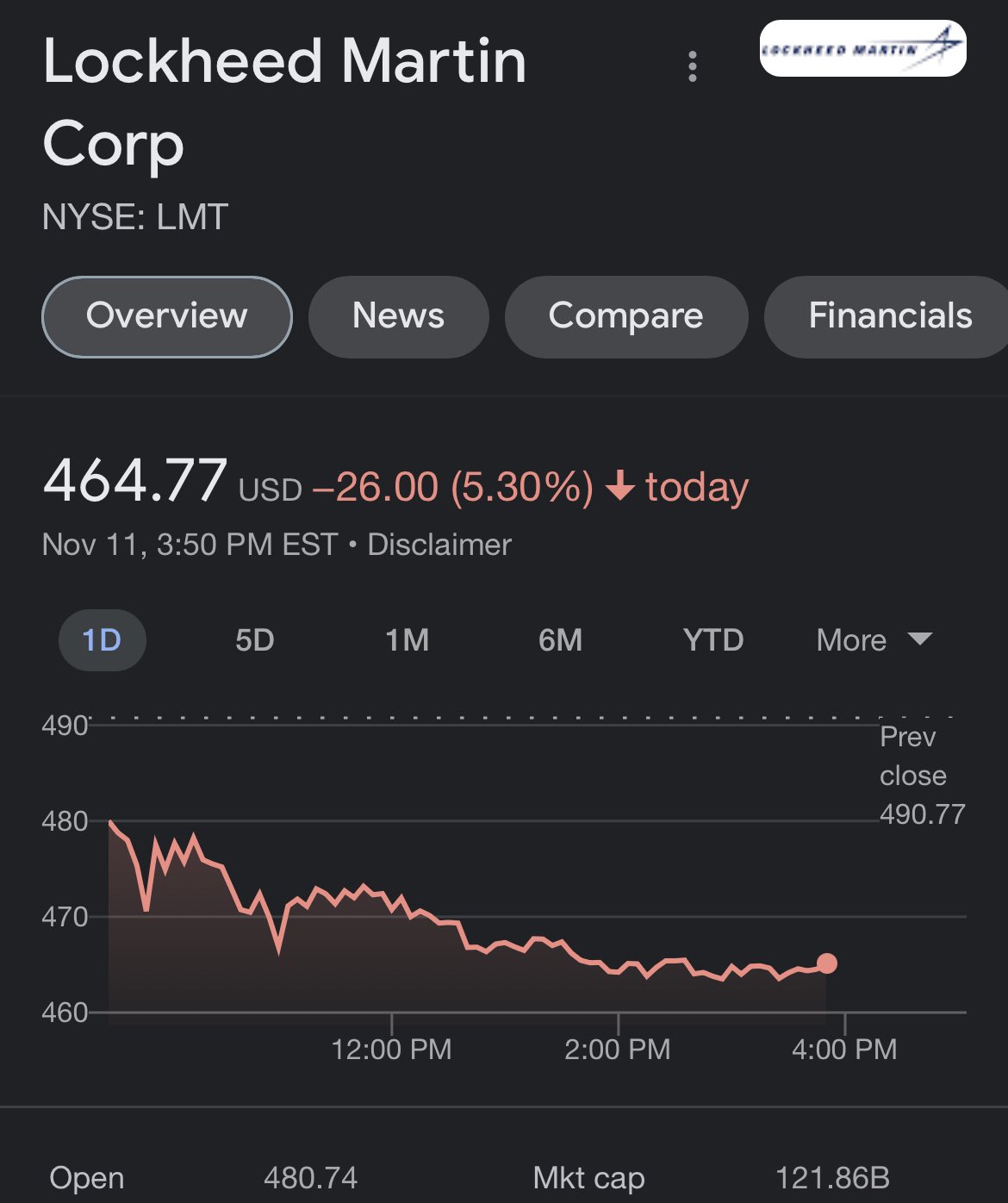Turkcell, Türk Telekom and Vodafone signed cooperation for local messaging and social media applications. Turkcell, Türk Telekom customers and Vodafone İletişim Pass users will be able to use BiP and Yaay without spending their internet quotas.
Latest Thread
You are using an out of date browser. It may not display this or other websites correctly.
You should upgrade or use an alternative browser.
You should upgrade or use an alternative browser.
Social Media Platforms
- Thread starter Bogeyman
- Start date

De fleste kender Remee fra »X Factor« – de færreste som iværksætter: »Jeg ser ikke mig selv som forretningsmand i konventionel forstand«
2020 blev et godt år for sangskriveren Remee, der efter årelang kamp endelig har fået en betroet »gulddreng« dømt for misbrug af kreditkort. »Mine børn skal vide, hvordan det hænger sammen,« siger Remee Jackman.
danish songwriter and entrepreneur owner of social works is making a difference through social media and such. It’s pretty impressive and important to be aware of the power of social media.
Big increase in interest in domestic application BIP in Bangladesh
Bangladeshi journalist Aoulad Hüseyin told Anadolu Agency, "I think using BiP is safer than WhatsApp because the BIP guarantees that users will keep all their information safe." used the expression.
Saying that the changes in WhatsApp's privacy policy pushed him to switch, Hüseyin said, "Since WhatsApp decided to share users' information with Facebook, I was concerned about my privacy and I decided to switch to BiP." said.
Turkey and the Erdogan administration has affected the adoption love
Professor of Information Technologies Institute of Dhaka University. Stating that users are naturally interested in something new, Zerina Begüm said, "Thus, the newly introduced BiP attracted the attention of people and the gap created by WhatsApp's controversial move played an important role in gaining popularity of the application." found the assessment.
Bangladeshis participate in voicing positive thoughts about Turkey Begum, Turkey and Prime Minister Recep Tayyip Erdogan in use in Bangladesh adopted the practice of feeling that he is a great role.
Capital Oli Rahman, a student at Dhaka, AA said in a statement to reporters, "particularly courageous leaders of Turkey and Turkish TV series, including Recep Tayyip Erdogan Resurrection Ertugrul, organizations Osman and Awakening: I love the Great Seljuks too. That's why I downloaded the Turkish application BiP as my main messaging application and from now on I will use it instead of WhatsApp. " said.
Information technology specialist Rakibul Islam, the status of the BIP Turkey praised the initiative and said that the theme should add more features as options.
According to data from the Bangladesh Telecommunications Regulatory Commission, about 27 million people use smartphones.
According to MobileAction, one of the world's leading app store optimization and mobile app software platforms, BiP currently ranks top among the most downloaded instant messaging apps by Android users in Bangladesh.
The increase in the downloads of BiP gained momentum worldwide after WhatsApp, which has more than 2 billion users, recently introduced controversial changes to its privacy policy that allowed it to share more data with parent company Facebook.
While the BIP drops WhatsApp to the second place in Bangladesh, it is followed by imo, Facebook Messenger and Telegram Messenger.
More than 50 million downloads
According to yesterday's data from Google Play Store, BiP has been downloaded by more than 50 million users worldwide.
Offering a wide range of helpful features such as instant translation into 106 languages worldwide and exchange rate, the application offers secure, easy-to-use and free communication. Users can also make video and audio calls with up to 10 people at the same time.

 www.aa.com.tr
www.aa.com.tr
Bangladeshi journalist Aoulad Hüseyin told Anadolu Agency, "I think using BiP is safer than WhatsApp because the BIP guarantees that users will keep all their information safe." used the expression.
Saying that the changes in WhatsApp's privacy policy pushed him to switch, Hüseyin said, "Since WhatsApp decided to share users' information with Facebook, I was concerned about my privacy and I decided to switch to BiP." said.
Turkey and the Erdogan administration has affected the adoption love
Professor of Information Technologies Institute of Dhaka University. Stating that users are naturally interested in something new, Zerina Begüm said, "Thus, the newly introduced BiP attracted the attention of people and the gap created by WhatsApp's controversial move played an important role in gaining popularity of the application." found the assessment.
Bangladeshis participate in voicing positive thoughts about Turkey Begum, Turkey and Prime Minister Recep Tayyip Erdogan in use in Bangladesh adopted the practice of feeling that he is a great role.
Capital Oli Rahman, a student at Dhaka, AA said in a statement to reporters, "particularly courageous leaders of Turkey and Turkish TV series, including Recep Tayyip Erdogan Resurrection Ertugrul, organizations Osman and Awakening: I love the Great Seljuks too. That's why I downloaded the Turkish application BiP as my main messaging application and from now on I will use it instead of WhatsApp. " said.
Information technology specialist Rakibul Islam, the status of the BIP Turkey praised the initiative and said that the theme should add more features as options.
According to data from the Bangladesh Telecommunications Regulatory Commission, about 27 million people use smartphones.
According to MobileAction, one of the world's leading app store optimization and mobile app software platforms, BiP currently ranks top among the most downloaded instant messaging apps by Android users in Bangladesh.
The increase in the downloads of BiP gained momentum worldwide after WhatsApp, which has more than 2 billion users, recently introduced controversial changes to its privacy policy that allowed it to share more data with parent company Facebook.
While the BIP drops WhatsApp to the second place in Bangladesh, it is followed by imo, Facebook Messenger and Telegram Messenger.
More than 50 million downloads
According to yesterday's data from Google Play Store, BiP has been downloaded by more than 50 million users worldwide.
Offering a wide range of helpful features such as instant translation into 106 languages worldwide and exchange rate, the application offers secure, easy-to-use and free communication. Users can also make video and audio calls with up to 10 people at the same time.

Bangladeş'te yerli uygulama BİP’e ilgide büyük artış
Türkiye'nin iletişim ve yaşam platformu BiP, WhatsApp'ta mahremiyetin korunmasına ilişkin endişelerin ardından Bangladeşli kullanıcılar tarafından en çok tercih edilen uygulama oldu. - Anadolu Ajansı
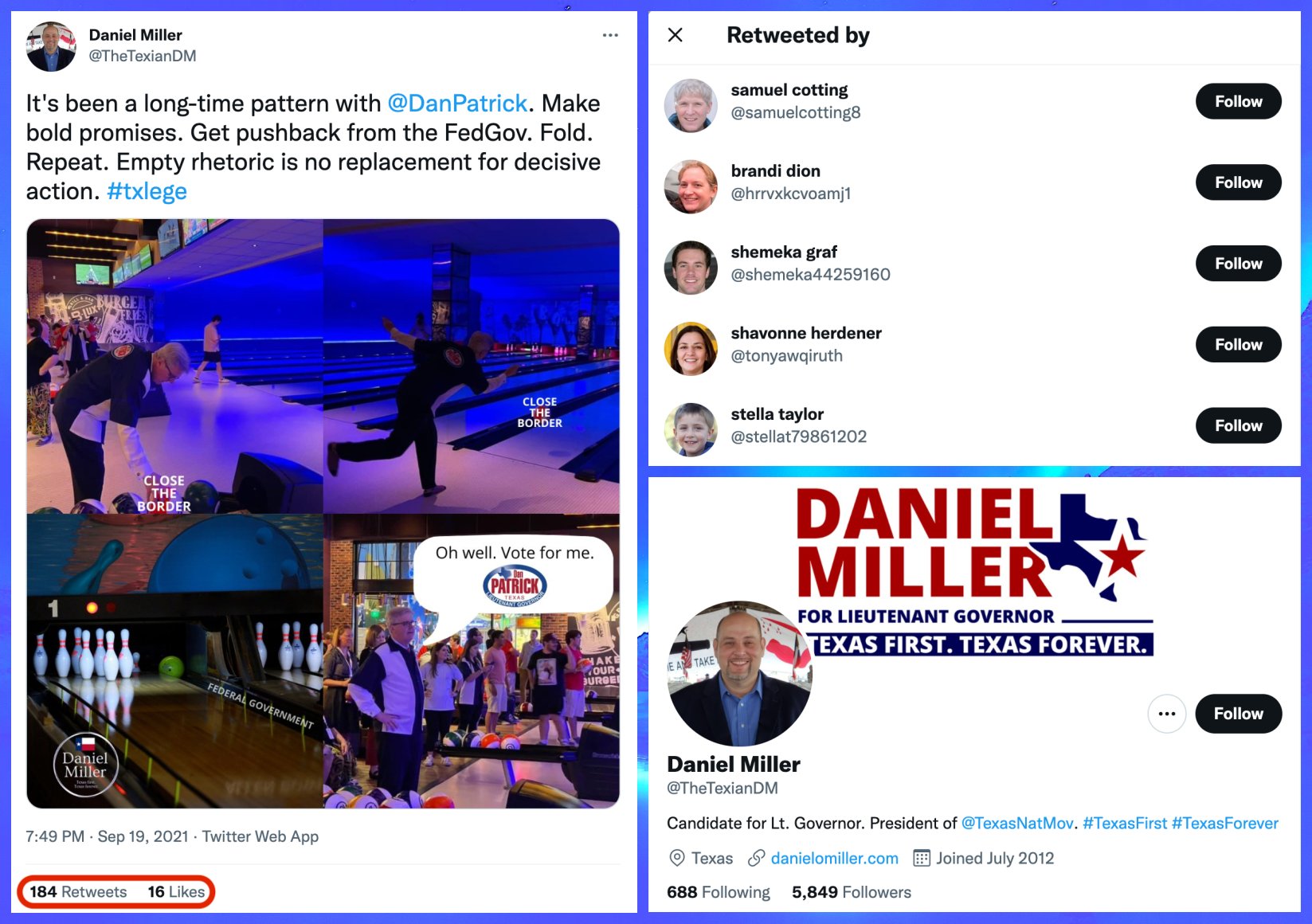
@Ryder @Cabatli_TR @Mis_TR_Like @Test7 @Nilgiri @Zafer @TR_123456 @Combat-Master
Twitter has now become a platform that intelligence agencies use as a weapon to shoot operations. Designed and produced boots get blue ticks.
Twitter has now become a platform that intelligence agencies use as a weapon to shoot operations. Designed and produced boots get blue ticks.
Musk's buyout of Twitter clearly changed the status quo. I hope our boys back at Ankara is not sitting idly by, and doing their part.

OMG. What a mess! LM will ofc recover from this but Twitter is in real trouble.
and this is a kneejerk way to do things.
Imagine doing this kind of PR play towards all 500 companies in the S&P 500 index simultaneously. while using bot accounts on places like Robinhood to exercise put options towards said companies stocks and funneling the gains towards your nation with crypto and such.
600 years worth of plunder, gone in a blink of an eye!
This war correspondent does not exist
Russia’s 2022 invasion of Ukraine has been accompanied by widespread interest in real-time news and information on the conflict, and an explosion of Ukraine-themed “news” accounts on social media have emerged, purportedly to provide coverage. Healthy skepticism of accounts of this sort is warranted, however, as many are not as they seem. One popular tactic: creating a “journalist” by renaming an old Twitter account, slapping an artificially generated or stolen/stock photo on it, and tweeting plagiarized content or outright falsehoods as “breaking news”. Here are three examples of “journalist” accounts made in this manner, all of which use GAN-generated faces. (GAN = “generative adversarial network”, the machine learning technology behind tools like https://thispersondoesnotexist.com and https://generated.photos.)

screenshot of @BethBoykins22’s Twitter profile, taken March 1st, 2022
In March 2022, a supposedly Ukraine-based Twitter “journalist” by the name of @BethBoykins22 with a GAN-generated face started tweeting out news about the war in Ukraine, usually with accompanying videos. None of @BethBoykins22’s “reporting” was original, however — both the videos and the tweet text were copied verbatim from a mix of public figures such as Alexander Vindman and random “breaking news” Twitter accounts (some of which likely also plagiarized the content).
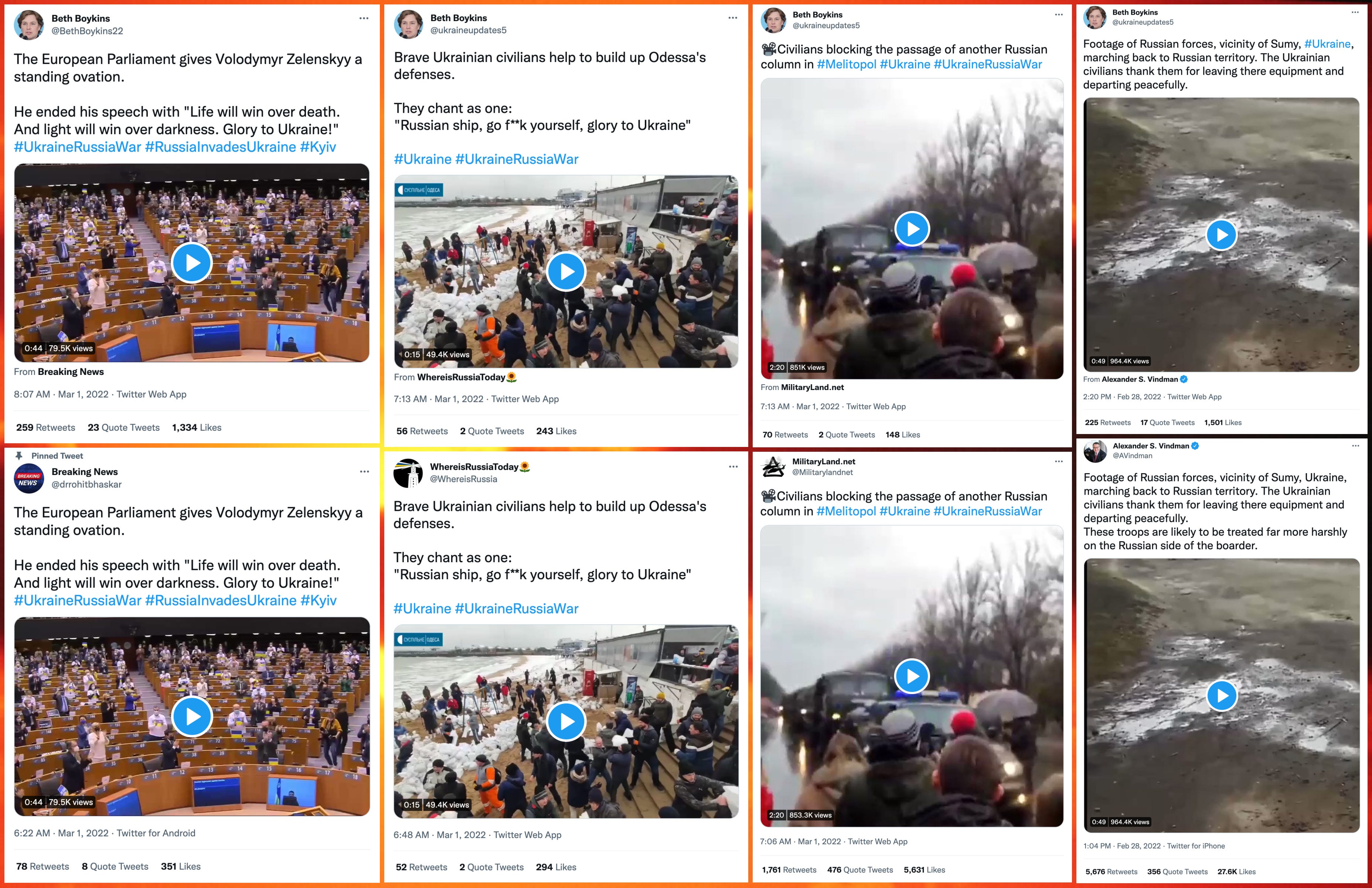
war reporting is so much less dangerous when you copy and paste

the account name can change, but the ID remains the same
Every account on Twitter has a permanent numeric account ID that remains constant even if the account’s handle, display name, or biography is changed. This can be used to confirm suspected handle changes. In the case of @BethBoykins22, this numeric ID is 860123802684051456, and a search of the Wayback Machine for archives of one of the account’s tweets reveals that as recently as February 21st, 2022, the account was named @iflehbrahim7 and claimed to reside in Arkansas rather than Ukraine.
Tweets also have numeric IDs (they’re even part of the tweet URL), and much like the account ID, they remain the same when the account is renamed.
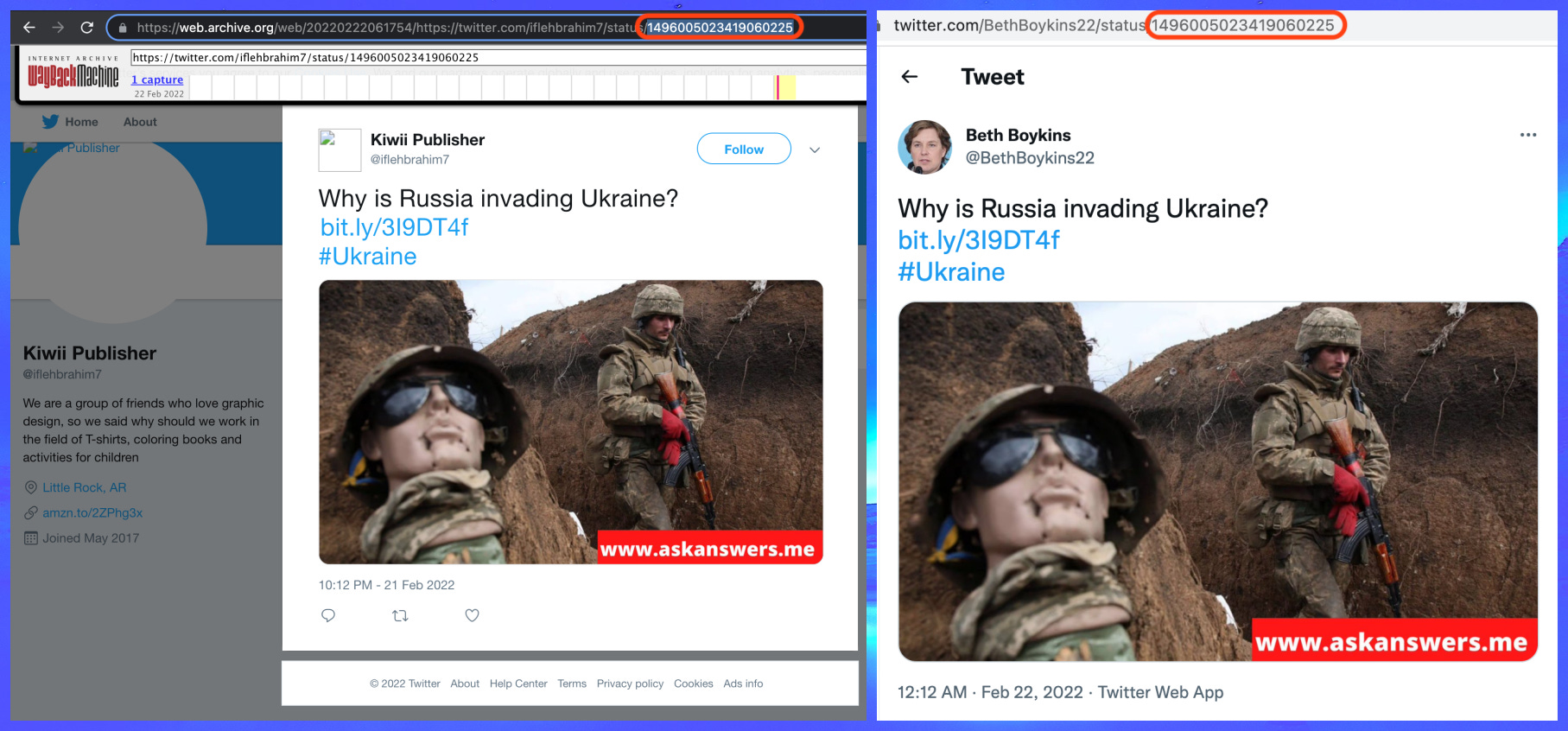
the tweet ID remains constant even when the account name changes
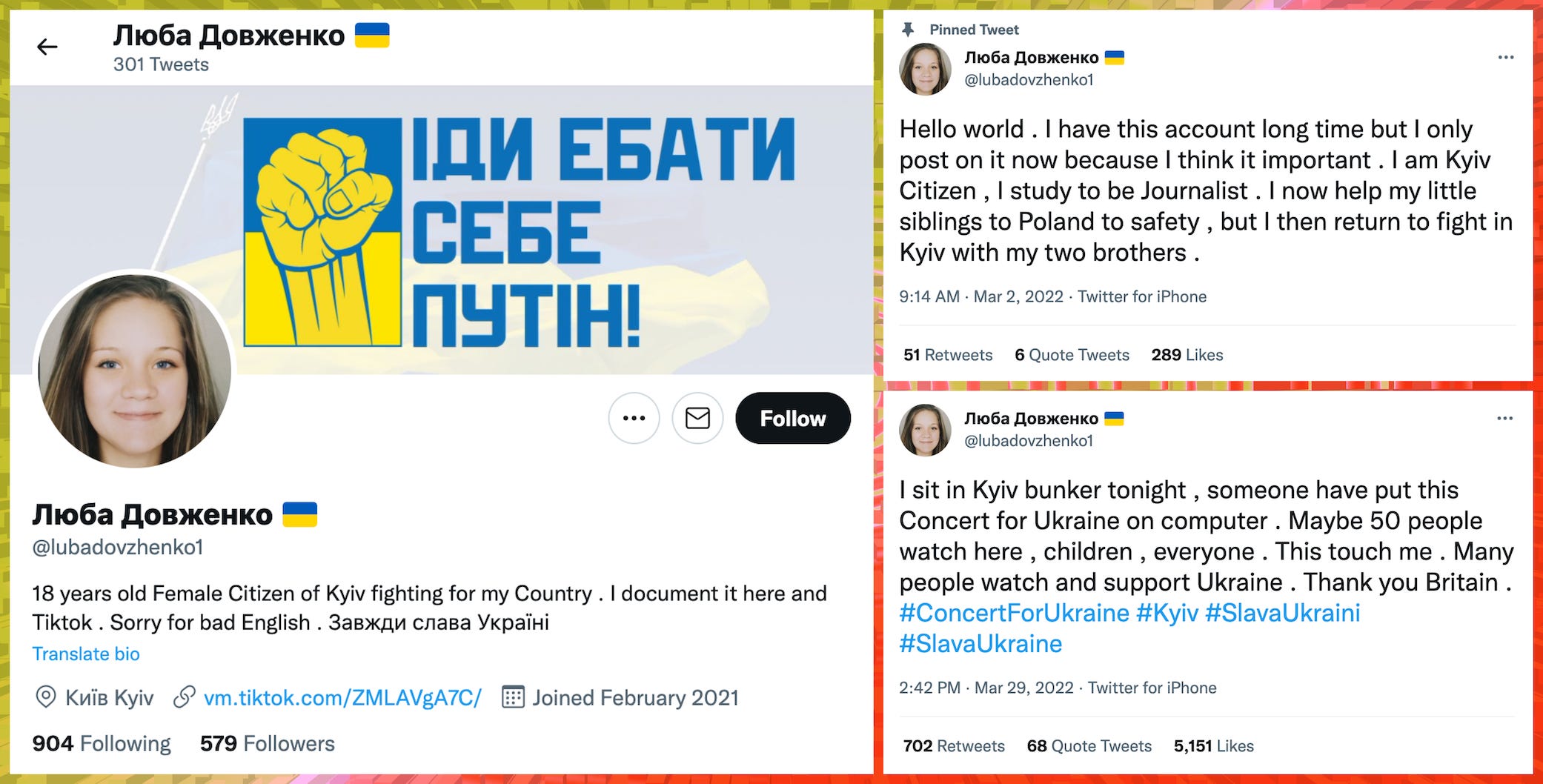
almost none of this is real, as it turns out
On March 2nd, 2022, a Twitter account named @lubadovzhenko1 with a GAN-generated face began tweeting about the war. Although the account operator claimed to be a journalism student with poor English skills and no previous Twitter experience, this is far from accurate; the account was simply renamed and purged of old tweets. Wayback Machine confirms that the @lubadovzhenko1 account (numeric ID 1357665122395815940) was named @camplostkids prior to the invasion of Ukraine, and several of the deleted tweets show fluent usage of conversational English.
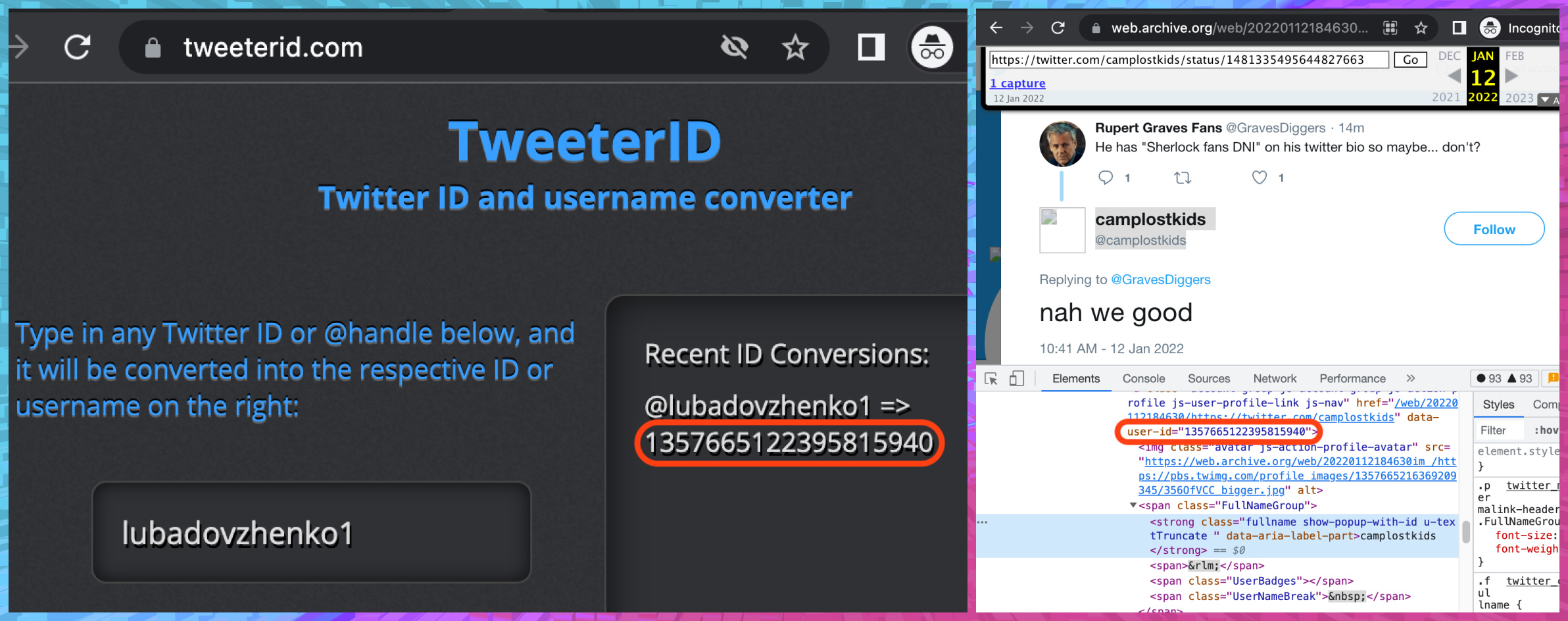
the archived @camplostkids has the same numeric ID as @lubadovzhenko1, hence they are the same account
https://substackcdn.com/image/fetch...eed-97ab-48cb-a341-820da49a1e06_1615x1016.png

in an amazing twist, the English in the old tweets is just fine
https://substackcdn.com/image/fetch...6e9b-edbc-46d5-8dc9-135510dbc18a_1775x637.png
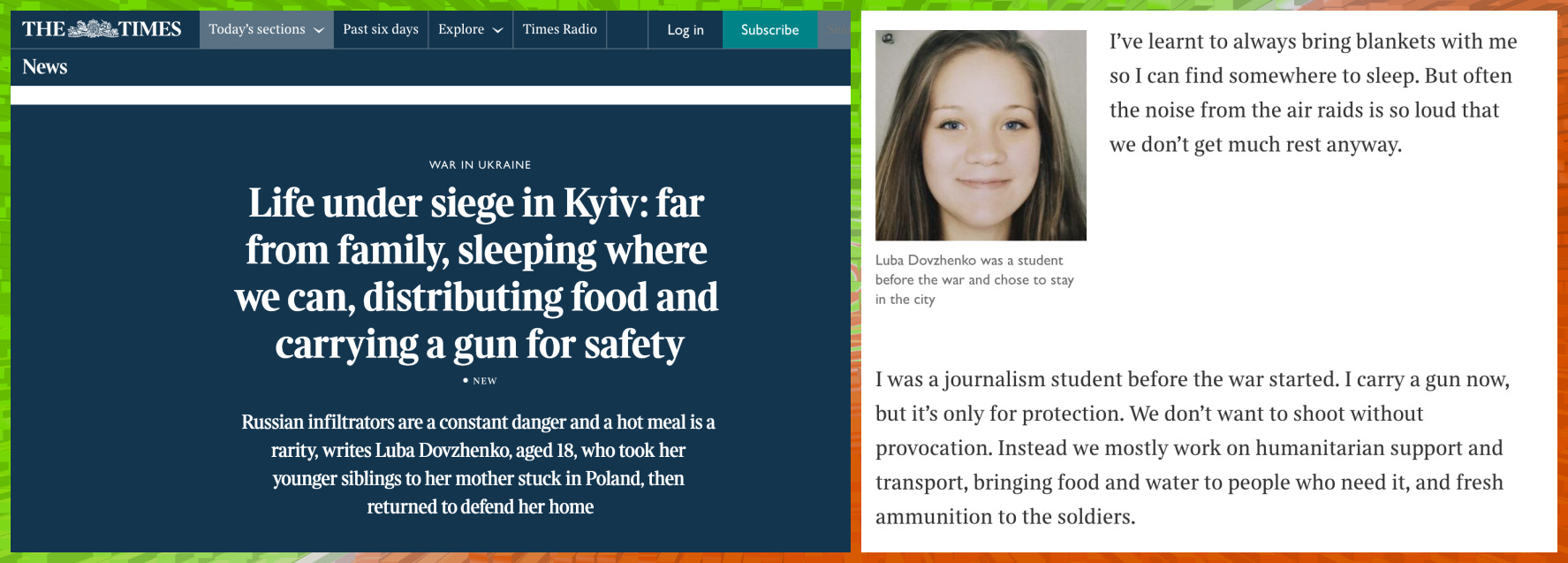
this journalism student does not exist but got published anyway (briefly)
This particular fake journalist account even managed to get a guest column in a major UK media outlet. On March 17th, 2022, The Times published a piece on wartime life in Kyiv allegedly written by @lubadovzhenko1 (as “Luba Dovzhenko”) and featuring the same GAN-generated face as the Twitter account. After the @lubadovzhenko1 account was exposed as inauthentic and covered by France 24, The Times belatedly removed the guest article

artificially generated faces from generated.photos can often be found in the site’s curated collection, making detection easy
https://substackcdn.com/image/fetch...081-0a9b-4d13-9571-c585be781a2a_1748x1321.png
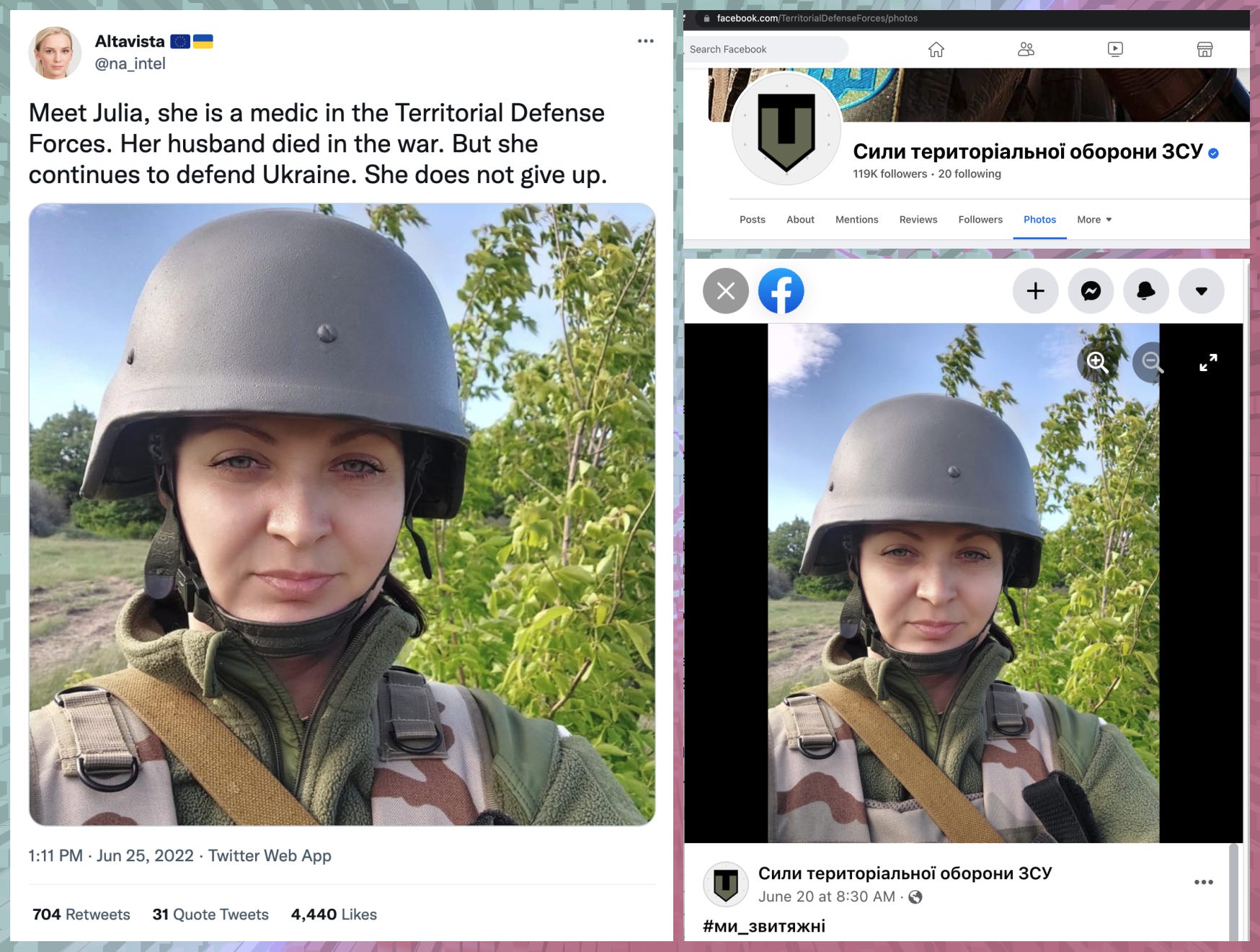
plagiarism takes a lot less effort than journalism
In mid-2022, an “Open Source Intelligence” Twitter account with the handle @na_intel and a GAN-generated face from https://generated.photos went viral by “reporting” on the war in Ukraine via plagiarized photos from official Ukrainian military Facebook pages. As with the two other accounts discussed in this article, the @na_intel account (numeric ID 873220123) has been renamed at least once. In an interesting twist, this account has used multiple GAN-generated faces: immediately prior to being renamed to @na_intel, it was named @kristoferso and bore a different GAN-generated face, and has also repeatedly promoted a Patreon account featuring yet another GAN-generated face (also obtained from https://generated.photos).

same GAN-tastic account, different GAN-tastic face
https://substackcdn.com/image/fetch...e85e-5f5d-4a10-870e-69f5fa65462d_2505x868.png

if you want to pay $6 a month for stolen content from an account with multiple fake faces, this is a great opportunity

https://substackcdn.com/image/fetch...081-0a9b-4d13-9571-c585be781a2a_1748x1321.png
How can we tell that the “faces” these three accounts used as profile images are artificially generated? There are multiple signs, including but not limited to:
- deformed microphone that melts into @BethBoykins22’s clothing and face
- surreal clothing on @BethBoykins22’s image
- boundaries between hair and background are unrealistic in areas containing loose strands of hair
- @na_intel’s ears do not match
These three accounts have all been suspended by Twitter, but they are by no means the only examples of fake “journalist” accounts on Twitter (or other social media platforms) posting about the war in Ukraine or other topics. The methods they utilized — GAN-generated faces, recycling old accounts rather than creating new ones, and building an audience by presenting plagiarized media content as breaking news — continue to be commonplace. This type of deception is particularly concerning on Twitter at present in light of ongoing plans to include a blue verification checkmark with the Twitter Blue monthly subscription service, as inauthentic “journalist” accounts accompanied by blue checks are more likely to be seen as legitimate than the accounts describe in this article.

This war correspondent does not exist
A rogue's gallery of renamed Twitter accounts with artificially generated faces masquerading as journalists covering the war in Ukraine
Fake Friends: Leak Reveals Israeli Firms Turning Social Media Into Spy Tech
Like most of the public, A., a former Israeli journalist, knows little to nothing about the OSINT industry. However, the OSINT system sold by an Israeli-owned cyber firm being revealed here for the first time knows a lot about her – and about all of us, too.
Forbidden Stories, a non-profit dedicated to following up on the work of journalists who are killed or threatened for their reporting, found the firm and a brochure detailing their suite of digital surveillance tools in a trove of more than 500,000 documents belonging to the Military Forces of Colombia. They were leaked to Forbidden Stories by a collective of hackers known as Guacamaya and investigated as part of a global investigation involving different media outlets – among them Haaretz.
The leaked documents reveal the so-called social media surveillance industry and how just one mistaken friend request on Facebook can expose you and your entire network.
The technology this firm and others like it offer is part of what is called the OSINT – or Open Source Intelligence – industry. It’s a wide term, originating in the world of military intelligence and referencing intelligence collected through open sources like public databases or online maps as opposed to human or electronic sources like wiretapping.
However, in recent years, its usage in the private sector has been somewhat perverted to now include sources that are not really open. For example, information scraped from social media platforms like Facebook and Instagram that go to great lengths to protect user data - for both privacy and financial reasons.
A Haaretz investigation with Forbidden Stories reveals an entire digital surveillance industry that siphons personal data and gathers private information off the internet using fake online accounts known as avatars. Unlike avatars aimed at amplifying content, these avatars serve a different purpose – collection.
As exposed in our “agents of chaos” investigation last week, the avatars used in the disinformation industry play a public role by acting as agents of influence. OSINT industry avatars, on the other hand, are secret agents tasked with collecting as much information as they can from as many social networks as possible – all without being detected.
The firms active in the OSINT industry sell their technology to defense, law enforcement and intelligence agencies across the world. This includes militaries who have abused the technology and used it against journalists. The Colombian military, for example, was involved in such a scandal in 2020 and, as this investigation shows, was actively looking to obtain OSINT technology again last year.
Fake friends
It all starts with a notification – a new friend or follower request. The account looks real. Nothing suspicious. If you’re Israeli, maybe they look Israeli, too. Maybe it’s a face you recognize from last night’s protest. You accept the request and forget about it – but their work has only just begun. They now have authorized access to the information on your profile - and to that of your friends and family.“People need to stop talking about bots – the real threat today is avatars,” said Danny (Dennis) Citrinowicz, an Israel-based OSINT researcher, industry expert and non-resident fellow at the Atlantic Council.
“The goal in the industry is to have avatars, as many well developed and mature avatars as possible. The technology used in this context is called ‘mass avatar management systems’. And we’re not talking about one or two accounts, but thousands of them that you need to manage in a way that will not get caught by the social media platforms.”
In 2021, Meta, the parent company of Facebook and Instagram, began cracking down on OSINT firms and companies in the private surveillance sector.
In its report on the “surveillance-for-hire” industry, Meta’s threat intelligence team identified three stages of surveillance – reconnaissance (silently collecting information), engagement (contacting targets) and exploitation (hacking and phishing). The investigation concluded that “targeting is in fact indiscriminate and includes journalists, dissidents, critics of authoritarian regimes, families of opposition and human rights activists.”
In January, Meta sued Voyager Labs for using 38,000 fake Facebook accounts to scrape information from 600,000 users for at least three months. The lawsuit also alleges that, in addition to Facebook and Instagram, Voyager Labs employed fake accounts to gather data from Twitter, Youtube, LinkedIn and Telegram as well. The data included posts, likes, friends, photos, comments and information from groups and pages.
“This industry covertly collects information that people share with their community, family and friends, without oversight or accountability, and in a way that may implicate people’s civil rights,” a Meta representative said in a statement.
These were the exact capacities pitched by then-Israel-based Voyager Labs to Colombia, where OSINT surveillance tools have been used to profile and intimidate journalists and activists. Between 2018 and 2019, dozens of journalists were targets of Colombian military intelligence using an open-source monitoring tool sold by Voyager Labs called VoyagerAnalytics.
Documents show the company met again with Colombian intelligence officials in Spring 2022, though Voyager Labs did not respond to requests for comment.
Cognyte, another Israeli firm, also pitched their technology – albeit for an interception system – to the Colombian military, according to the leaked documents.
In February 2021, U.S.-Israeli company Verint spun-off its intelligence-cyber solutions division into a standalone company traded on the Nasdaq called Cognyte.
Verint today is focused on artificial intelligence and data analysis technology, but in the past it sold advanced monitoring technology to repressive regimes in Azerbaijan, Indonesia, South Sudan, Uzbekistan and Kazakhstan.
Cognyte currently shares the same address in the central Israeli city of Herzliya with Verint and provides the cyberintelligence services Verint once did. A Haaretz investigation revealed its mass surveillance technology was sold to Myanmar in recent years.
Cognyte was also called out by Meta in its December 2021 report on the surveillance industry for its use of avatars, which Meta says were employed to target journalists in countries like Chile.
The current leak revealed that the firm pitched its OSINT system to the Chilean army, though it is unclear if anything came of either of the pitches. Cognyte did not respond for comment.
Tel Aviv-Bogota-Singapore
No one can explain why A.’s name, photo and personal details appeared in a report produced by S2T Unlocking Cyberspace, a shadowy cybersecurity company being revealed here for the first time. Her name appears in a sample “target report” included in the S2T pitch deck, part of the massive trove of leaked documents belonging to the Military Forces of Colombia. It is unclear whether her Facebook account was compromised or her data was automatically scraped for a target report to present to clients.Reporters working on the investigation traced the brochure to S2T, a digital service firm with current or former offices in Singapore, Sri Lanka, the U.K. and Israel by matching graphics and tech descriptors on their website with those in the brochure. (S2T did not respond to requests for comment.)
S2T was founded in 2002 by entrepreneur Ori Sasson. It claims to have dozens of clients across five continents and employs people from intelligence agencies in the U.K., the U.S., Russia and Israel, as well as local law enforcement in the Middle East, South and Central America and Asia.
The “target report” with A.’s details was part of a wider pitch to the Colombian military intelligence. It was intended to show their program’s ability to not just collect data but also automatically create reports about targets.
The firm bills itself as an open-source intelligence (OSINT) company, yet the brochure advertises tools beyond typical OSINT, including an automated phishing tool to remotely install malware; massive advertising databases to track targets; and automated influence operations using fake accounts to trick unsuspecting targets.
Cyber-HUMINT
S2T’s brochures show a clear funnel of surveillance that also involves actual spyware: First a target or potential targets are located on social media, and then the mass avatar system begins to engage. The information they collect then leads to more targets – for example social groups.In the next phase, the avatars are even used as digital agents of sorts to try to penetrate closed groups or even actively engage with a target via private message, such as trying to get them to click an infected hyperlink. The documents suggest that once infected, the spyware can even remotely turn on the camera of its victim’s phone and secretly record them – a far cry from any definition of an open source.
The use of avatars in such a targeted way is called “cyber HUMINT” – or digital human intelligence, with the fake account playing the role of the human agent making contact with the real human target.
“A good avatar is like an agent,” explains a senior source in the Israeli open source and social media intelligence industry. “You need to develop them like you would a real agent to be able to send them into the field or in this case to actually have the avatar engage with a target.”
Once a friend request is accepted, once entrance to a group is granted, the avatars have access. On a Facebook or WhatsApp group for political activists, for example, the access gained by the digital agent working on behalf of a local police or intel agency could have devastating effects in the real world.
A former employee at S2T who spoke with Haaretz on condition of anonymity said the firm has long offered cyber-HUMINT capabilities. “People think that because it’s supposedly open sources that are being scraped to create this type of intelligence then it’s okay, that it can’t be misused. But if you’re using data that people don’t understand they’ve given you access to then that’s not really okay.”
In a cover letter addressed to Colombian military intelligence, S2T promotes its tools as helping to fight “malicious” groups, including: “terrorists, cyber criminals, [and] anti-government activists.” The brochure later shows how operators can “identify targets for further investigation” starting from a “database of known activists.”
One screenshot suggests an Indian client may have been interested in acquiring this tool for monitoring protest movements on social media. Among at least a dozen case studies from February 2020 are examples showing how the tool was used to analyze “dynamic keywords” related to student protests in 2020 against India’s 2019 Citizenship Amendment Act and what is likely a reference to 2019’s Jammu and Kashmir internet shutdowns.
Forbidden Stories identified clients in Singapore and Israel and possible customers in Bangladesh, Turkey, Sri Lanka, India and Malaysia. According to a brochure from one its resellers, S2T appears to have worked on behalf of a “Turkish political party,” using social media avatars to join closed groups and collect intel on opponents.
According to S2T’s website, other clients include “a Media group in Central America” and a “South American nation” where its tools were used to find “relevant information about the mastermind behind a kidnapping.” The brochure also discusses demos perhaps given in 2020, including to the Indian Navy and Dato’ Mohamed Lofty Bin Mohamed Noh, a businessman in Malaysia.
The former employee said the firm has long wanted to enter the South American market and was aiming for private sector clients as well.
While it is unclear whether these entities purchased S2T’s platform, Forbidden Stories and its partners identified one probable client: Bangladesh’s Directorate General of Forces Intelligence (DGFI).
An S2T subsidiary appears to have made a shipment to the DGFI in December 2021 or January 2022, which Forbidden Stories confirmed through concordant trade data. The revelation follows a Haaretz investigation that found Bangladesh’s intelligence services purchased other Israeli-linked tech in 2022, including spying vehicles that could intercept mobile and internet traffic.
Bangladesh’s solicitation of such tools aligns with its public statements. In January, according to The Business Standard, the country’s Home Minister announced that it would be introducing an integrated lawful interception system “in a bid to monitor social media platforms and thwart various anti-state and anti-government activities.”
Sasson and S2T refused to respond to this report.
When asked if the Israeli Defense Ministry oversees or regulates the sales and exports of such intelligence systems to military bodies, as it does with cyber arms, the ministry said in response: “Cyber technologies that are regulated in Israel [based on the Wassenaar Arrangement] are systems and equipment used to wiretap or monitor audio or data communications, as well as products related to penetrative programs,” or spyware. “As a policy, the Defense Ministry does not comment about its defense export policies for defense, national and strategic considerations.”

Fake friends: Leak reveals Israeli firms turning social media into spy tech
Avatars Are Not Used Just to Push Out Disinformation. A Massive Leak of 500,000 Documents Reveals How Fake Online Accounts Are Also Used to Spy on Journalists and Activists
New Batch of Classified Documents Appears on Social Media Sites
A new batch of classified documents that appear to detail American national security secrets from Ukraine to the Middle East to China surfaced on social media sites on Friday, alarming the Pentagon and adding turmoil to a situation that seemed to have caught the Biden administration off guard.
The scale of the leak — analysts say more than 100 documents may have been obtained — along with the sensitivity of the documents themselves, could be hugely damaging, U.S. officials said. A senior intelligence official called the leak “a nightmare for the Five Eyes,” in a reference to the United States, Britain, Australia, New Zealand and Canada, the so-called Five Eyes nations that broadly share intelligence.
The latest documents were found on Twitter and other sites on Friday, a day after senior Biden administration officials said they were investigating a potential leak of classified Ukrainian war plans, include an alarming assessment of Ukraine’s faltering air defense capabilities. One slide, dated Feb. 23, is labeled “Secret/NoForn,” meaning it was not meant to be shared with foreign countries.
The Justice Department said it had opened an investigation into the leaks and was in communication with the Defense Department but declined to comment further.
Mick Mulroy, a former senior Pentagon official, said the leak of the classified documents represents “a significant breach in security” that could hinder Ukrainian military planning. “As many of these were pictures of documents, it appears that it was a deliberate leak done by someone that wished to damage the Ukraine, U.S., and NATO efforts,” he said.
One analyst described what has emerged so far as the “tip of the iceberg.”
Early Friday, senior national security officials dealing with the initial leak, which was first reported by The New York Times, said a new worry had arisen: Was that information the only intelligence that was leaked?
By Friday afternoon, they had their answer. Even as officials at the Pentagon and national security agencies were investigating the source of documents that had appeared on Twitter and on Telegram, another surfaced on 4chan, an anonymous, fringe message board. The 4chan document is a map that purports to show the status of the war in the eastern Ukrainian city of Bakhmut, the scene of a fierce, monthslong battle.
But the leaked documents appear to go well beyond highly classified material on Ukraine war plans. Security analysts who have reviewed the documents tumbling onto social media sites say the increasing trove also includes sensitive briefing slides on China, the Indo-Pacific military theater, the Middle East and terrorism.
The Pentagon said in a statement on Thursday that the Defense Department was looking into the matter. On Friday, as the disclosures widened, department officials said they had nothing to add. But privately, officials in several national security agencies acknowledged both a rush to find the source of the leaks and a potential for what one official said could be a steady drip of classified information posted on sites.
The documents on Ukraine’s military appear as photographs of charts of anticipated weapons deliveries, troop and battalion strengths, and other plans. Pentagon officials acknowledge that they are legitimate Defense Department documents, but the copies appear to have been altered in certain parts from their original format. The modified versions, for example, overstate American estimates of Ukrainian war dead and underestimate estimates of Russian troops killed.
On Friday, Ukrainian officials and pro-war Russian bloggers suggested the leak was part of a disinformation effort by the other side, timed to influence Ukraine’s possible spring offensive to reclaim territory in the east and the south of the country.
A senior Ukrainian official said that the leak appeared to be a Russian ploy to discredit a counteroffensive. And the Russian bloggers warned against trusting any of the information, which one blogger said could be the work of “Western intelligence in order to mislead our command.”
Behind closed doors, chagrined national security officials were trying to find the culprit. One official said it was likely that the documents did not come from Ukrainian officials, because they did not have access to the specific plans, which bear the imprint of the offices of the Pentagon’s Joint Staff. A second official said that determining how the documents were leaked would start with identifying which officials had access to them.
The first tranche of documents appeared to have been posted in early March on Discord, a social media chat platform popular with video gamers, according to Aric Toler, an analyst at Bellingcat, the Dutch investigative site.
In Ukraine, Lt. Col. Yurii Bereza, a battalion commander with Ukraine’s National Guard whose forces have fought in the country’s east in recent months, shrugged off news of the leak.
He noted that information warfare had become so intense that “we can no longer determine where is the truth and where is the lie.”
“We are at that stage of the war when the information war is sometimes even more important than the direct physical clashes at the front,” Colonel Bereza said.
A soldier in his unit, Maksym, had yet to hear the news. “We have a lot of our own problems, and with this leak I have no words,” he said angrily.
Outside experts said it was difficult to draw conclusions about who released the information and why.
Kyle Walter, the head of research at Logically, a British firm that tracks disinformation, said many prominent voices on Russian Telegram channels were calling the original, apparently unaltered photo showing Russian and Ukrainian casualties a “Western influence” operation.
“They think the actual unedited photo where it shows high Russian loss numbers and relatively low Ukrainian loss numbers is an attempt to instill poor morale in Russia and Russian forces,” Mr. Walter said.
Jonathan Teubner, the chief executive of FilterLabs AI, which tracks messaging in Russia, said that while pro-Kremlin voices were saying the leak was an American or Ukrainian disinformation campaign, his lead analyst thought it could be a Russian operation meant to sow distrust between Washington and Kyiv.
The doctored photo showing lower casualty numbers for Russia, and higher ones for Ukraine, than reported figures has been discussed far more frequently in Western-oriented social media than in Russian-focused platforms, Mr. Walter said.
It has been a frequent Russian disinformation tactic to alter stolen documents, including some purportedly leaked from the Ukrainian government, Mr. Walter said. But because Ukraine’s government has dismissed these documents as altered or out of context, they generally do not gain much traction, he added.
“There are a lot of examples of leaked documents being used in propaganda campaigns and specifically in terms of disinformation,” Mr. Walter said. But what is going on with these American documents, he added, “is still pretty unclear at the moment.”
The Ukraine war, Mr. Walter said, has had more document leaks than other conflicts, in part because of the role that open-source intelligence and declassified intelligence have played in the war.
“There’s definitely been an uptick, it’s happening more often, but that’s more indicative of just the environment we’re in rather than it being the tactic specific to the Ukraine war,” Mr. Walter said.

New Batch of Classified Documents Appears on Social Media Sites (Published 2023)
Secret documents that appear to detail American national security secrets on Ukraine, the Middle East and China have surfaced online.
This war correspondent does not exist
Russia’s 2022 invasion of Ukraine has been accompanied by widespread interest in real-time news and information on the conflict, and an explosion of Ukraine-themed “news” accounts on social media have emerged, purportedly to provide coverage. Healthy skepticism of accounts of this sort is warranted, however, as many are not as they seem. One popular tactic: creating a “journalist” by renaming an old Twitter account, slapping an artificially generated or stolen/stock photo on it, and tweeting plagiarized content or outright falsehoods as “breaking news”. Here are three examples of “journalist” accounts made in this manner, all of which use GAN-generated faces. (GAN = “generative adversarial network”, the machine learning technology behind tools like https://thispersondoesnotexist.com and https://generated.photos.)

screenshot of @BethBoykins22’s Twitter profile, taken March 1st, 2022
In March 2022, a supposedly Ukraine-based Twitter “journalist” by the name of @BethBoykins22 with a GAN-generated face started tweeting out news about the war in Ukraine, usually with accompanying videos. None of @BethBoykins22’s “reporting” was original, however — both the videos and the tweet text were copied verbatim from a mix of public figures such as Alexander Vindman and random “breaking news” Twitter accounts (some of which likely also plagiarized the content).

war reporting is so much less dangerous when you copy and paste

the account name can change, but the ID remains the same
Every account on Twitter has a permanent numeric account ID that remains constant even if the account’s handle, display name, or biography is changed. This can be used to confirm suspected handle changes. In the case of @BethBoykins22, this numeric ID is 860123802684051456, and a search of the Wayback Machine for archives of one of the account’s tweets reveals that as recently as February 21st, 2022, the account was named @iflehbrahim7 and claimed to reside in Arkansas rather than Ukraine.
Tweets also have numeric IDs (they’re even part of the tweet URL), and much like the account ID, they remain the same when the account is renamed.

the tweet ID remains constant even when the account name changes

almost none of this is real, as it turns out
On March 2nd, 2022, a Twitter account named @lubadovzhenko1 with a GAN-generated face began tweeting about the war. Although the account operator claimed to be a journalism student with poor English skills and no previous Twitter experience, this is far from accurate; the account was simply renamed and purged of old tweets. Wayback Machine confirms that the @lubadovzhenko1 account (numeric ID 1357665122395815940) was named @camplostkids prior to the invasion of Ukraine, and several of the deleted tweets show fluent usage of conversational English.

the archived @camplostkids has the same numeric ID as @lubadovzhenko1, hence they are the same account
https://substackcdn.com/image/fetch/f_auto,q_auto:good,fl_progressive:steep/https://bucketeer-e05bbc84-baa3-437e-9518-adb32be77984.s3.amazonaws.com/public/images/d9c69eed-97ab-48cb-a341-820da49a1e06_1615x1016.png

in an amazing twist, the English in the old tweets is just fine
https://substackcdn.com/image/fetch/f_auto,q_auto:good,fl_progressive:steep/https://bucketeer-e05bbc84-baa3-437e-9518-adb32be77984.s3.amazonaws.com/public/images/6bdb6e9b-edbc-46d5-8dc9-135510dbc18a_1775x637.png

this journalism student does not exist but got published anyway (briefly)
This particular fake journalist account even managed to get a guest column in a major UK media outlet. On March 17th, 2022, The Times published a piece on wartime life in Kyiv allegedly written by @lubadovzhenko1 (as “Luba Dovzhenko”) and featuring the same GAN-generated face as the Twitter account. After the @lubadovzhenko1 account was exposed as inauthentic and covered by France 24, The Times belatedly removed the guest article

artificially generated faces from generated.photos can often be found in the site’s curated collection, making detection easy
https://substackcdn.com/image/fetch/f_auto,q_auto:good,fl_progressive:steep/https://bucketeer-e05bbc84-baa3-437e-9518-adb32be77984.s3.amazonaws.com/public/images/37a94081-0a9b-4d13-9571-c585be781a2a_1748x1321.png

plagiarism takes a lot less effort than journalism
In mid-2022, an “Open Source Intelligence” Twitter account with the handle @na_intel and a GAN-generated face from https://generated.photos went viral by “reporting” on the war in Ukraine via plagiarized photos from official Ukrainian military Facebook pages. As with the two other accounts discussed in this article, the @na_intel account (numeric ID 873220123) has been renamed at least once. In an interesting twist, this account has used multiple GAN-generated faces: immediately prior to being renamed to @na_intel, it was named @kristoferso and bore a different GAN-generated face, and has also repeatedly promoted a Patreon account featuring yet another GAN-generated face (also obtained from https://generated.photos).

same GAN-tastic account, different GAN-tastic face
https://substackcdn.com/image/fetch/f_auto,q_auto:good,fl_progressive:steep/https://bucketeer-e05bbc84-baa3-437e-9518-adb32be77984.s3.amazonaws.com/public/images/5fcce85e-5f5d-4a10-870e-69f5fa65462d_2505x868.png

if you want to pay $6 a month for stolen content from an account with multiple fake faces, this is a great opportunity

https://substackcdn.com/image/fetch/f_auto,q_auto:good,fl_progressive:steep/https://bucketeer-e05bbc84-baa3-437e-9518-adb32be77984.s3.amazonaws.com/public/images/37a94081-0a9b-4d13-9571-c585be781a2a_1748x1321.png
How can we tell that the “faces” these three accounts used as profile images are artificially generated? There are multiple signs, including but not limited to:
Additionally, GAN-generated faces in wide circulation (including those used by these three accounts) have the telltale trait that prominent facial features are drawn in the same location on every image, regardless of what direction the “face” appears to be looking in. For example, the eyes are always horizontally positioned halfway between the center and edge of the image, and vertically 7/8 the distance from top to center. (@na_intel’s profile image has been cropped and does not have this property, but since the image provably originated with https://generated.photos and has other weird artifacts, we can safely conclude that it is GAN-generated.)
- deformed microphone that melts into @BethBoykins22’s clothing and face
- surreal clothing on @BethBoykins22’s image
- boundaries between hair and background are unrealistic in areas containing loose strands of hair
- @na_intel’s ears do not match
These three accounts have all been suspended by Twitter, but they are by no means the only examples of fake “journalist” accounts on Twitter (or other social media platforms) posting about the war in Ukraine or other topics. The methods they utilized — GAN-generated faces, recycling old accounts rather than creating new ones, and building an audience by presenting plagiarized media content as breaking news — continue to be commonplace. This type of deception is particularly concerning on Twitter at present in light of ongoing plans to include a blue verification checkmark with the Twitter Blue monthly subscription service, as inauthentic “journalist” accounts accompanied by blue checks are more likely to be seen as legitimate than the accounts describe in this article.

This war correspondent does not exist
A rogue's gallery of renamed Twitter accounts with artificially generated faces masquerading as journalists covering the war in Ukraineconspirator0.substack.com
It feels like we are nearing that moment like in the movie "the running man" where the news report/footage is completely fabricated. What happens when they can digitally create any real life, anyone at any moment can turn into an enemy of the state.
Leader of Online Group Where Secret Documents Leaked Is Air National Guardsman
The leader of a small online gaming chat group where a trove of classified U.S. intelligence documents leaked over the last few months is a 21-year-old member of the intelligence wing of the Massachusetts Air National Guard, according to interviews and documents reviewed by The New York Times.The national guardsman, whose name is Jack Teixeira, oversaw a private online group named Thug Shaker Central, where about 20 to 30 people, mostly young men and teenagers, came together over a shared love of guns, racist online memes and video games.
Two U.S. officials confirmed that investigators want to talk to Airman Teixeira about the leak of the government documents to the private online group. One official said Airman Teixeira might have information relevant to the investigation.
Federal investigators have been searching for days for the person who leaked the top secret documents online but have not identified Airman Teixeira or anyone else as a suspect. The F.B.I. declined to comment.
Starting months ago, one of the users uploaded hundreds of pages of intelligence briefings into the small chat group, lecturing its members, who had bonded during the isolation of the pandemic, on the importance of staying abreast of world events.
The New York Times spoke with four members of the Thug Shaker Central chat group, one of whom said he has known the person who leaked for at least three years, had met him in person, and referred to him as the O.G. The friends described him as older than most of the group members, who were in their teens, and the undisputed leader. One of the friends said the O.G. had access to intelligence documents through his job.
While the gaming friends would not identify the group’s leader by name, a trail of digital evidence compiled by The Times leads to Airman Teixeira.
The Times has been able to link Airman Teixeira to other members of the Thug Shaker Central group through his online gaming profile and other records. Details of the interior of Airman Teixeira’s childhood home — posted on social media in family photographs — also match details on the margins of some of the photographs of the leaked secret documents.
The Times also has established, through social media posts and military records, that Airman Teixeira is enlisted in the 102nd Intelligence Wing of the Massachusetts Air National Guard. Posts on the unit’s official Facebook page congratulated Airman Teixeira and colleagues for being promoted to Airman First Class in July 2022.
On Thursday, President Biden said the United States was “getting close” to finding answers about the leak.
“There’s a full blown investigation going on, as you know, with the intelligence community and the Justice Department, and they’re getting close,” Mr. Biden told reporters on a visit to Dublin.
It was not immediately clear if a young Air National Guardsman in his position could have had access to such highly sensitive briefings. Officials within the U.S. government with security clearance often receive such documents through daily emails, one official told The Times, and those emails might then be automatically forwarded to other people.
Airman Teixeira’s mother, Dawn, speaking outside her home in Massachusetts on Thursday, confirmed that her son was a member of the Air National Guard and said he had recently been working overnight shifts at a base on Cape Cod. In the last few days, he had changed his phone number, she said.
Later, someone who appeared to be Airman Teixeira drove onto the property in a red pickup truck.
When Times reporters approached the house again, the truck was parked in the driveway. Airman Teixeira’s mother and a man were standing outside in the driveway.
When asked if Airman Teixeira was there and willing to speak, the man said: “He needs to get an attorney if things are flowing the way they are going right now. The Feds will be around soon, I’m sure.”
Members of Thug Shaker Central who spoke to The Times said that the documents they discussed online were meant to be purely informative. While many pertained to the war in Ukraine, the members said they took no side in the conflict.
The documents, they said, only started to get wider attention when one of the teenage members of the group took a few dozen of them and posted them to a public online forum. From there they were picked up by Russian-language Telegram channels and then The New York Times, which first reported on them.
The person who leaked, they said, was no whistleblower, and the secret documents were never meant to leave their small corner of the internet.
“This guy was a Christian, anti-war, just wanted to inform some of his friends about what’s going on,” said one of the person’s friends from the community, a 17-year-old recent high school graduate. “We have some people in our group who are in Ukraine. We like fighting games, we like war games.”

F.B.I. Arrests National Guardsman in Leak of Classified Documents (Published 2023)
Authorities say Jack Teixeira, a 21-year-old member of the Massachusetts Air National Guard, posted sensitive materials in an online chat group.





